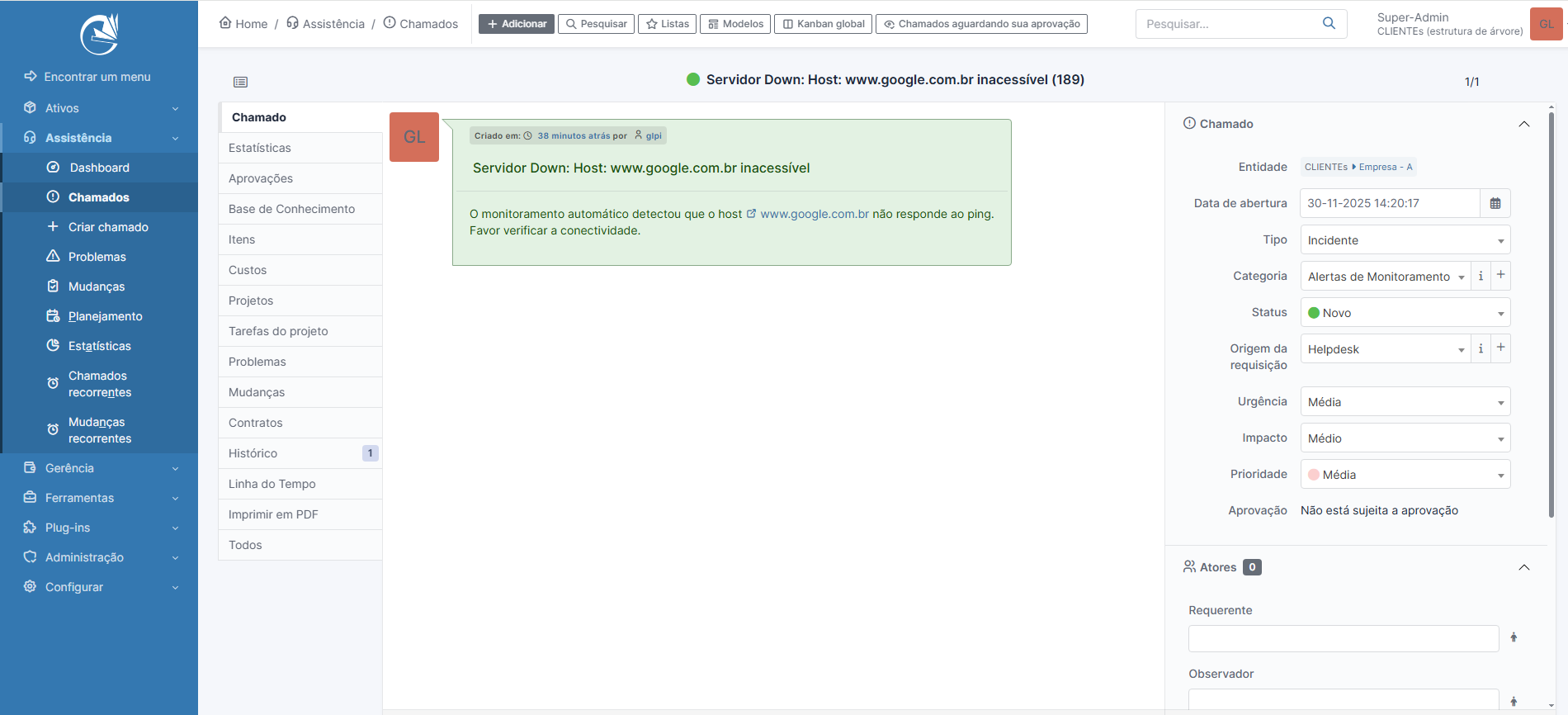Please check if the feature has not already been requested.
If not, please describe it

 Feature Request: Button Actives for current user in Help Desk
Feature Request: Button Actives for current user in Help Desk
There is a possibility to add feature in a future a button to list all the current actives in the logged user in helpdesk
Even its possible to send a notification when a active is assigned to an user.


 gantt plugin - Proposal new features
gantt plugin - Proposal new features
We use the plugin and it works very well for us, but we are missing some functionalities. Could you consider including them in future versions?
- Improvements for the filter: make it search in the titles of projects, tasks, and subtasks.
- Export format: try to add some format like PDF or Excel for printing.
- Add the option to Show/Hide linked tickets in subtasks and make them clickable. The idea is that it should be optional. They should only be displayed if "Show" is selected.
- Add the possibility to add tickets directly, just like it currently allows adding new subtasks. Provide the option to add tickets in subtasks and have them linked to the project and the project task.

 GLPIPlanning.getHeight in planning.js
GLPIPlanning.getHeight in planning.js
I'm using GLPI 11.0.4 as a Docker container.
In planning view I was not able to use the full available window height.
The only method I found was to manually edit line 93 of file planning.js inside the container, from
height: options.height,
to
height: '100%',
and fully refresh the page in browser.
This value seems to have a default value set at line 55
height: GLPIPlanning.getHeight,
This behaviour is a bit annoying because I have to reproduce this modification at every containter recreation.
It should be nice if that value was parameterized somehow as many other parameters are already.

 Sequential Approval in Enterprise Service Management
Sequential Approval in Enterprise Service Management
I’m trying to implement sequential approvals on Enterprise Service Management forms/tickets. I attempted to use Business Rules, but as soon as I add an additional criterion—such as Description → Contains, alongside Approval → Granted—the rule fails to trigger.
My requirement is to have different approvers for different types of service requests (e.g., recruitment requests, termination requests, leave requests). At any stage, if an approval is refused, the approval flow should stop and the ticket should close.
The challenge is that I cannot add additional criteria in the Business Rule to differentiate request types; as a result, the rule would apply globally to all tickets where approval is granted, forcing me to configure only one user or one group as the second-level approver—which defeats the purpose. ESM forms require different approvers depending on the request type.
Has anyone managed to solve this using Business Rules?
My other option is to explore configuring Entities, which in theory should work—but so should the rules, at least on paper. :(

 [Feature Request - GLPI 11] UX Improvement: Grouping items in the "Assets" menu
[Feature Request - GLPI 11] UX Improvement: Grouping items in the "Assets" menu
Bonjour l'équipe et la communauté,
Je souhaite proposer une amélioration concernant l'interface utilisateur de GLPI 11, spécifiquement au niveau du menu Parc (Assets).
Le constat : Actuellement, tous les types d'équipements (Ordinateurs, Moniteurs, Réseau, Imprimantes, Périphériques, etc.) sont listés au même niveau sous le menu "Parc". Avec l'ajout d'objets personnalisés, cette liste devient très longue et difficile à scanner visuellement.
La proposition : Serait-il possible d'introduire une fonctionnalité (native ou via configuration UI) permettant de créer des sous-groupes visuels ou des séparateurs dans ce menu ?
L'idée n'est pas de changer la structure de la base de données, mais uniquement l'organisation visuelle du menu.
Exemple d'organisation :
Parc
--- Infrastructure --- (Séparateur ou Sous-menu)
Réseau
Rack
PDU
--- Postes de travail ---
Ordinateurs
Moniteurs
--- Périphériques ---
Imprimantes
Téléphones
Cela améliorerait grandement la navigation au quotidien pour les techniciens. Qu'en pensez-vous ?
Merci pour votre excellent travail sur la v11 !

 Include Asset Definitions in capacities for an Asset Definition
Include Asset Definitions in capacities for an Asset Definition
Hi,
Currently, an asset definition instance can't be configured to allow displaying links to other asset definition instances.
An example:
I have an Asset Definition "A" and another Asset Definition "B".
Asset Definition "B" contains a custom field linking to an instance of Asset Definition "A".
When I open my instance of Asset Definition "A" I cannot see any reference to the linked Asset Definition "B" instance.
GLPI should be improved to allow me to se this relation, just as I can see all other relations (via the Capacities configuration page for the Asset Definition).
In my above example the asset relation is: Asset Definition "B" 0..* -- 0..1 Asset Definition "A".
Kind regards,
Peter

 ICMP (Ping) to server, open a support ticket if down.
ICMP (Ping) to server, open a support ticket if down.
Eu criei uma página ICMP.php via API ela abre um ticket baseado em um ping para um determinado servidor via IP . Gostaria que validasse esta função, para melhorar e acrescentar no GLPI assim não preciso integrar o zabbix no GLPI.


CÓDIGO UTILIZADO COMO FONTE EU ADAPTEI O MEU ATE CHEGAR NO PONTO AI DO CHAMADO JÁ CRIADO AO GLPI.
?php
// --- PARTE 1: Configurações e Função de Ping ---
// Configurações do GLPI
$glpi_url = 'http://<seu-servidor-glpi>/apirest.php/'; // Ex: http://localhost/glpi/apirest.php/
$app_token = '<SEU_APP_TOKEN>';
$user_token = '<SEU_USER_TOKEN>';
$entidade_id = 0; // ID da entidade (0 para entidade raiz ou o ID específico)
$categoria_id = 0; // ID da categoria do chamado (ex: 9 para Problema de Rede )
$user_id = 1; // **[NOVO]** ID do usuário solicitante (substitua pelo ID real do usuário no GLPI)
// Endereço IP ou hostname a ser pingado
$target_host = '8.8.8.8'; // Ex: IP do servidor ou Google DNS
// Função para verificar se o host está online (simples ICMP ping)
function is_host_online($host) {
// Comando ping para sistemas Linux. Ajuste para Windows se necessário.
$command = 'ping -c 3 ' . escapeshellarg($host);
exec($command, $output, $status);
return ($status === 0);
}
// --- PARTE 2: Lógica Principal ---
if (!is_host_online($target_host)) {
echo "Falha no ping para {$target_host}. Abrindo chamado no GLPI...\n";
// **[MODIFICADO]** Passando o novo user_id para a função
create_glpi_ticket($glpi_url, $app_token, $user_token, $entidade_id, $categoria_id, $target_host, $user_id);
} else {
echo "O host {$target_host} está online. Nenhum chamado foi aberto.\n";
}
// --- PARTE 3: Função para Criar Chamado no GLPI via API ---
// **[MODIFICADO]** Adicionando $user_id como parâmetro
function create_glpi_ticket($url, $app_token, $user_token, $entity_id, $category_id, $host, $user_id) {
// 1. Iniciar sessão para obter o Session Token
$session_token = get_glpi_session_token($url, $app_token, $user_token);
if (!$session_token) {
echo "Erro: Não foi possível obter o Session Token.\n";
return;
}
// 2. Criar o chamado (Ticket)
$ticket_data = json_encode([
'input' => [
'name' => "FALHA DE PING: Host {$host} inacessível", // Título do chamado
'content' => "O monitoramento automático detectou que o host {$host} não responde ao ping.\nFavor verificar a conectividade.", // Descrição
'status' => 1, // Status: Novo
'urgency' => 3, // Urgência: Média
'priority' => 3, // Prioridade: Média
'entities_id' => $entity_id,
'itilcategories_id' => $category_id,
'requesttypes_id' => 1, // Tipo de requisição (1 para Incidente, ajuste se necessário)
'users_id' => $user_id // **[NOVO]** Define o usuário solicitante pelo ID
]
]);
$ch = curl_init("{$url}Ticket");
curl_setopt($ch, CURLOPT_CUSTOMREQUEST, 'POST');
curl_setopt($ch, CURLOPT_POSTFIELDS, $ticket_data);
curl_setopt($ch, CURLOPT_RETURNTRANSFER, true);
curl_setopt($ch, CURLOPT_HTTPHEADER, array(
'Content-Type: application/json',
'App-Token: ' . $app_token,
'Session-Token: ' . $session_token
));
$result = curl_exec($ch);
$httpcode = curl_getinfo($ch, CURLINFO_HTTP_CODE);
curl_close($ch);
if ($httpcode == 201) {
echo "Chamado criado com sucesso! Código de status: {$httpcode}\n";
} else {
echo "Erro ao criar chamado. Código de status: {$httpcode}. Resposta: {$result}\n";
}
// Opcional: Finalizar sessão
// logout_glpi_session($url, $app_token, $session_token);
}
function get_glpi_session_token($url, $app_token, $user_token) {
$ch = curl_init("{$url}initSession");
curl_setopt($ch, CURLOPT_RETURNTRANSFER, true);
curl_setopt($ch, CURLOPT_HTTPHEADER, array(
'Content-Type: application/json',
'App-Token: ' . $app_token,
'Authorization: user_token ' . $user_token
));
$result = curl_exec($ch);
$httpcode = curl_getinfo($ch, CURLINFO_HTTP_CODE);
curl_close($ch);
if ($httpcode == 200) {
$response = json_decode($result, true);
return $response['session_token'];
}
return false;
}
// Função de logout opcional
function logout_glpi_session($url, $app_token, $session_token) {
$ch = curl_init("{$url}killSession");
curl_setopt($ch, CURLOPT_CUSTOMREQUEST, 'GET');
curl_setopt($ch, CURLOPT_RETURNTRANSFER, true);
curl_setopt($ch, CURLOPT_HTTPHEADER, array(
'Content-Type: application/json',
'App-Token: ' . $app_token,
'Session-Token: ' . $session_token
));
curl_exec($ch);
curl_close($ch);
}
?>
 ¿Como puedo generar un informe de los cambios que se hacen en los equipos?
¿Como puedo generar un informe de los cambios que se hacen en los equipos?
Hola buenas, me gustaria generar un informe/reporte diario que me informase si hubiera algun cambio en el hardware de los equipos para enterarme al momento

[Features] Stock/Warehouse state in Orders Plugin
Handling of order item status.
Adding items release status from warehouse/stock.
There is no warehouse/stock option where you can see how many items from
orders have been issued and how many we still have in warehouse/stock
available for transfer.
As a separate item in the “order/front/menu.php” menu with a table summarizing items from orders and the ability to filter them.

 [Question] Will file uploads on public forms return in GLPI 11?
[Question] Will file uploads on public forms return in GLPI 11?
Hello GLPI Team,
We were wondering if there are any plans to re-introduce file uploads on public (anonymous) forms for the GLPI 11 release.
We understand this feature was removed due to major security concerns, but it is a very valuable feature for many workflows.
Is a new, more secure implementation being considered or planned for version 11?
Thank you for your hard work!
Servicio de atención al cliente por UserEcho


